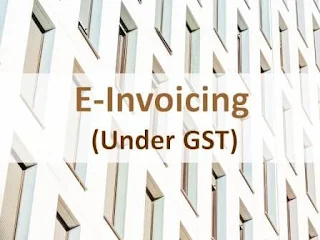E-Invoicing under GST is notified vide notification no. 68/2019 - Central Tax. It is a concept of submission of already generated invoice on a common e-invoice portal where authentication of invoices is checked in Invoice Registration Portal (IRP) resulting in generation of identification number against every invoice.
E-invoice
is not applicable to every business; the applicability of the same is based on
turnover of business.
By
using this concept tax authorities will have to access transactions and it was
implemented from 1st Oct 2020.
Let’s understand in detail the e-invoicing system and its limit under GST.
What is the E-Invoicing System under GST?
E-invoicing (Electronic
invoicing) is a system in which your invoices will be electronically
authenticated by GSTN.
It
covers B2B invoices (i.e. supplies mode to registered person). For this process
electronically authentication invoices registration portal (IRP) is developed.
Under
this IRP portal, invoices are electronically authenticating and an
identification number will be issued against each invoice.
The
benefit of e-invoicing is that once the IRP authenticates the invoices then it
will transfer all the invoice information to GST portal as well as e-way bill
portal.
So
as a result you do not need to enter the data in GSTR-1 manually it will be
filled automatically.
In
this way Invoice Registration Portal (IRP) will share information with GST
Portal as well as E-way bill portal.
Also Read: HSN Code (6 digits / 8 digits) Mandatory from 1st April 2021
What is the applicability of e-invoicing under GST?
Applicability
of e-invoicing is decided by aggregate turnover. E-invoicing made applicable
from 1st Oct 2020 to businesses having aggregate turnover exceeds Rs.500 Crore
in any of the preceding financial years from 2017-18 to 2019-20.
Later
on this limit of Rs. 500 crore is decreased to Rs.100 crore.
On
8th March 2021, Notification No. 5/2021-Central Tax, CBIC notified that e-invoicing
will be applicable from 1 April 2021 for businesses whose aggregate turnover is
any financial year from 2017-18 onwards, exceeds Rs.50 crore. Now this turnover limit is Rs.20 crore which is applicable with effect from 1st April 2022. The limit decreased from Rs.50 crore to Rs.20 crore by notification number 1/2022-Central Tax.
So,
now for the applicability of e-invoicing turnover limit is Rs. 20 crore.
What is the current turnover limit for issuing e-invoicing under GST?
Current
turnover limit for issuing e-invoicing is Rs. 20 crore (w.e.f. 1st
April, 2022). So, turnover limit will be applicable exceeding the limit Rs. 20
crore for issuing e-invoice.
Also Read: Composition Scheme under GST(For Goods and Services)
Whom e-invoicing is not applicable under GST?
There
are certain categories of registered persons to whom e-invoicing is not
applicable (whether or not turnover exceeds the limit). These are:
- Insurer or Banking Company or a Financial Institution (including NBFC)
- GTA (Goods Transport Agency)
- Registered person who is involved in supplying passenger transportation services.
- Registered person who is involved in supplying services by way of admission to the exhibition of cinematographic films in multiplex services.
What is the process of e-invoice under GST?
The
process of e-invoice is similar to already issuing invoices. In normal
scenarios, we generate invoices through software (Like. Tally) and then upload
the details in GSTR 1.
And
if there is a consignor or transporters then he must generate e-way bills by
importing the invoices in excel or JSON manually.
But
with the e-invoices this generating and uploading invoice will remain the same.
This will be done by importing from excel or JSON or via API integration.
Also Read: GST- QRMP Scheme (Quarterly Return Monthly Payment Scheme)
What are the benefits of E-invoicing under GST?
Following
are the benefits of e-invoicing under GST:
- Invoice registration portal (IRP) will transfer the information of invoices to GST portal as well as e-way bill portal. So it is helpful in the way that GSTR1 will automatically be filled.
- It helps in resolving the issue of mismatching (data reconciliation).
- On the introduction of e-invoicing the government will have the better check on transactions.
- Input tax credit will be made available fastly (because the authenticity of invoices checked through e-invoicing).
Summary
E-Invoicing under GST is a concept of electronically authentication of all B2B invoices. The applicability of this is based on aggregate turnover. By using this, the government will have better check on B2B transactions.


Post a Comment
If you have any query, Please let us know.